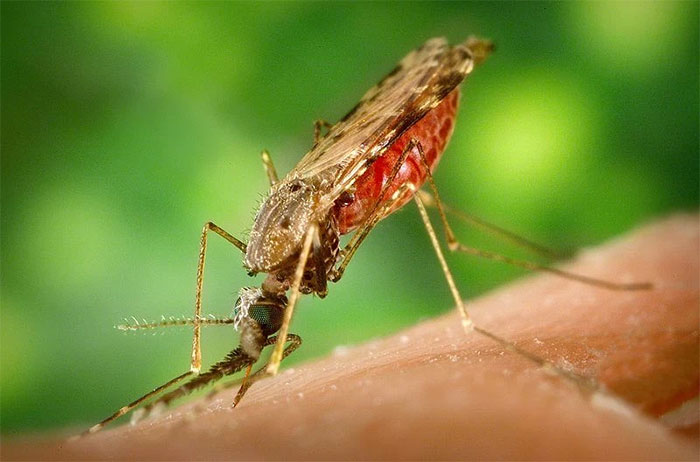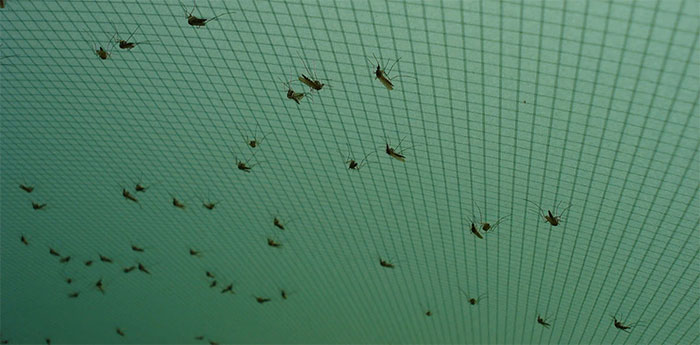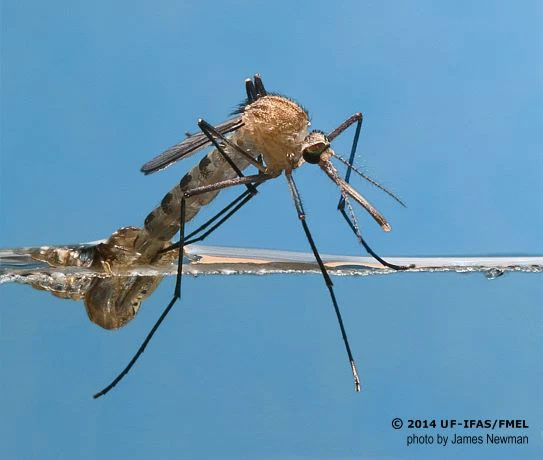Humanity has a saying: What doesn’t kill you makes you stronger. It turns out, this is also true for mosquitoes.
In a recent experiment, scientists found that most mosquitoes were able to survive exposure to not just one, but up to five common insecticides used worldwide.
Professor Frederic Tripet, a medical entomologist at Keele University, stated that the prospect of mosquitoes developing resistance to chemicals humans use to kill them has long been predicted. “We know it has been happening and is still happening. But we don’t really understand the process,” Professor Tripet said. “It is completely a black box.”
Together with his colleagues, he conducted a study to decode the chemical resistance process in mosquitoes. “We observed a common behavior where mosquitoes could learn very quickly from their previous encounters with insecticides,” Professor Tripet noted.

Mosquitoes can learn very quickly from their past encounters with insecticides.
The Mosquitoes and Humans in the Chemical Arms Race
For some, mosquitoes are just uninvited guests at outdoor barbecues. But for others, mosquito bites can lead to severe illnesses, hospitalization, or even death.
Species such as Aedes aegypti, commonly known as the yellow fever mosquito or Asian tiger mosquito, can carry numerous pathogens, including viruses that cause dengue fever, Zika, and chikungunya. Culex quinquefasciatus can transmit lymphatic filariasis.
Another dangerous mosquito species is Anopheles, which can transmit malaria parasites. They inhabit areas that could potentially expose half of the world’s population to disease.
Globally, there are over 3,500 species of mosquitoes, responsible for more than 725,000 deaths each year. These tiny creatures thus dominate the rankings of the deadliest animals on the planet.
Humans, with violence and war, rank second, while snakes come in third, causing about 50,000 deaths.

Mosquitoes dominate the rankings of the deadliest animals on the planet.
Recognizing the threat posed by mosquitoes, humans have been trying to find chemicals to kill them since the 1930s. To kill an adult mosquito, the chemical must first penetrate its tough outer shell, known as the cuticle.
Once inside the mosquito’s body, these chemicals must bind to receptors on the cells, similar to a key fitting into a lock, aiming to disable the mosquito’s nervous system.
Over time, humans have identified malathion, propoxur, deltamethrin, permethrin, and lambda-cyhalothrin as effective chemicals for this purpose. They are now used in most mosquito and insecticide products worldwide.
However, mosquitoes, as adaptable and evolving creatures, have begun developing ways to resist the chemicals humans use.
For example, some mosquito species have evolved to thicken their cuticle, making it more difficult for insecticides to penetrate their bodies. Others exhibit more sophisticated cellular characteristics, capable of altering the receptors on their cells, changing the “locks” so that the chemicals can no longer fit.
But there are also species of mosquitoes that simply resist chemicals through behavior, which are less studied. This is where Professor Tripet and his colleagues aim to delve deeper. He wants to understand what these mosquitoes do, when, and where to avoid the effects of human insecticides.

Some mosquitoes simply resist chemicals through behavior.
Suicide Mosquitoes
In his research, Professor Tripet selected two of the most potent disease-transmitting mosquito species: A. aegypti and C. quinquefasciatus.
Only female mosquitoes were chosen, as male mosquitoes typically do not bite humans and only feed on plant sap. The females, on the other hand, require blood as an important protein source for laying eggs.
First, Professor Tripet’s team exposed these mosquitoes to one of five common insecticides, ranging from malathion and propoxur to deltamethrin, permethrin, and lambda-cyhalothrin.
The dosage of the insecticide was limited to a level sufficient to repel the mosquitoes, killing a few, but not enough to wipe out the entire population. For the survivors post-exposure, Professor Tripet placed them into a tube. At one end, he introduced a mouse as bait.
Separating the mosquitoes from the mouse was a net that had been sprayed with the same insecticide they had encountered earlier. The goal was to see if the mosquitoes, after exposure to the chemicals, would dare to pass through the net to feed on the mouse.
The results showed that the majority of mosquitoes hesitated to do so. However, a significant number, 15% of A. aegypti and 12% of C. quinquefasciatus, bravely flew through the insecticide-laden net to reach the bait.
In a control test with the same number of mosquitoes from both species that had never been exposed to chemicals, up to 58% of A. aegypti and 54% of C. quinquefasciatus chose to fly through the net.
But a difference also emerged here. The mosquitoes that had previously been sprayed with insecticide had a survival rate twice as high compared to those that had never encountered the chemicals. This indicates they had adapted to that specific insecticide.

Mosquitoes have adapted to various chemicals.
In a series of other experiments, researchers provided the mosquitoes with a choice between two resting boxes. One emitted the scent of insecticide, while the other had the scent of silicon oil or olive oil.
Professor Tripet noted that mosquitoes previously exposed to insecticides chose the box with the oil scent. “They no longer wanted to land in the box with the insecticide scent,” he said.
This means that mosquitoes have adapted to various chemicals by identifying and avoiding contact with them.
“Insects, like many other living organisms, can learn what is harmful to them if they survive an initial encounter,” said Dr. Nancy Troyano, an entomologist. “Avoidance behavior based on previous exposure has also been demonstrated in other insect species, such as cockroaches.”
And when insecticides fail to kill them, these mosquitoes will continue to live longer, reproduce more, and likely in the future, you will face a smarter species of mosquitoes, Professor Tripet stated.
Small Insects, Big Behavioral Changes
Tanya Russell, a researcher at James Cook University, stated that Professor Tripet’s new research reaffirms what she and other medical entomologists worldwide have been concerned about for a long time.
“I am really pleased to see articles beginning to analyze how mosquitoes change their behavior in this way,” Russell said. Previously, she and her colleagues had also monitored a population of Anopheles mosquitoes carrying malaria parasites in the Solomon Islands and found that this species had altered their feeding habits to avoid insecticides applied to mosquito nets and walls in homes.

Mosquito control spraying.
Unlike the yellow fever mosquito that typically bites humans during the day, Anopheles mosquitoes usually only operate at night. However, in the Solomon Islands, they began to switch to daytime feeding when people are outdoors, especially during twilight when they cook and are not protected by nets or insecticides, Russell noted.
Initially, perhaps only a few Anopheles mosquitoes knew to shift their activity to earlier in the day. But gradually, this behavior was learned by the entire local mosquito population.
Russell stated that the change in mosquito behavior at the population level could be observed within 12 months. “It happens very quickly, very, very quickly,” she said.
So how can we better control mosquitoes?
The new research shows that some mosquito species can learn from their own experiences and change their behavior accordingly. But can this be passed down to their offspring?
“Of course it is possible, part of that behavior is what mosquitoes have inherited over time, as natural selection operates,” Professor Tripet said. He speculated that the mosquito population in West Africa “is now resistant to all the types of mosquito drugs you throw at them” and has accumulated this capability in their genetic makeup.
This will complicate efforts to control mosquito populations in other areas, and subsequently, diseases may increase again.

Cleaning up tree stumps, stagnant ponds, and standing water can also help control local mosquito populations.
Dr. Russell noted that the new research emphasizes the importance of monitoring mosquitoes in tropical and subtropical regions—not only looking for physiological variations but also behavioral changes.
Now, perhaps disease control agencies should focus on tools or techniques that help prevent mosquito populations without relying on the behavior of adult females.
For instance, they should aim to eliminate mosquitoes from their larval stages while they are still in the water as wriggling larvae.
Some mosquito species, including Aedes aegypti, prefer to lay eggs in small water containers, so cleaning up tree stumps and similar items may also help control local mosquito populations, Russell suggested.


















































